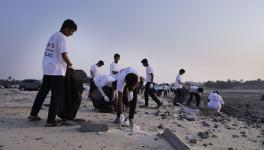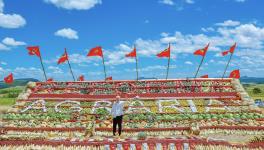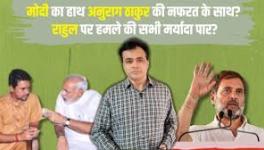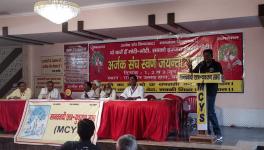To Solve Demand Crisis, Eliminate Dalit Landlessness
Image for representational use only.Image Courtesy : The Indian Express
Widespread dalit landlessness across India is one effect of the centuries-old caste system and associated practice of untouchability. Elimination of dalit landlessness is imperative, not only as a matter of human and Constitutional rights of the dalits and Scheduled Castes (SCs) but also to effectively tackle the economic problems that beset the nation at present—unemployment, under-employment, and the inability to achieve optimal economic growth on account of prevailing low demand for manufactured goods and services.
So far, economists and experts have discussed solutions to the ongoing slowdown in terms of lowering the rates of personal and corporate taxes, labour reforms to make the laws more “flexible”, land reforms to aid industrialisation, more public expenditure on infrastructure and so on. What is missing in all discussions on how to secure optimal growth and reduce unemployment and underemployment is recognising the importance of removing dalit landlessness.
The data shows that dalit share in agricultural land holdings, compared with their share in the rural population, is the least among all social classes. According to Census 2011, the SCs constitute 16.6% of the total population and 17.91% of the rural population. The National Sample Survey Organisation or NSSO, in its 66th round, surveys the proportion of rural SC households who own land to find they are at just 17.1%. By contrast, 39.4% of rural households belonging to the Socially Advanced Classes are “self-employed in agriculture”. (This proportion varies from state to state.)
It, therefore, follows that the largest number (and proportion) of dalits are engaged in some form of labour, agricultural or other rural and urban unorganised, in which they earn low wages that are far below a living wage.
Removing dalit landlessness, along with providing group minor irrigation on lands owned by SCs and Scheduled Tribes (STs), and other supporting measures, are essential. These will have a cascading beneficial effect on the national economy. The immediate effect of such a programme will be all year agricultural self-employment for the SCs and STs. Thus, chronic underemployment will be eliminated.
In August 2017, a three-year action agenda was released by the NITI Aayog saying that “...unemployment is the lesser of India’s problems. The more serious problem is severe underemployment.” On the accessory problem of low wages, the Aayog says, “….those in the workforce are employed, but they are overwhelmingly stuck in low-productivity, low-wage jobs.”
Land to landless dalits will generate fresh possibilities of growing high-value agricultural crops. If the rural job guarantee scheme, MGNREGA, is extended to these lands and its new dalit owners are provided wages under it, the potential for growing high-value horticultural crops also becomes available. A third advantage would be to engage SC and ST women in work on their own fields instead of labouring on other’s lands or homes. This will enable them to take up farm-based occupations, such as poultry and dairying as well.
Consequently, the purchasing power of a large segment of India’s subsistence level population will be augmented. Demand for a variety of goods and services that this section of the population needs, but cannot afford at their present income levels, would rise. In its report, the NITI Aayog also “rediscovers” this long-known socio-economic reality of India: it records that low wage “depresses demand” for manufactured goods and services.
The enhanced purchasing power of dalits, resulting from their empowerment with land ownership, will lead to full utilisation of the idle capacity of manufacturing and service units. This will make it possible to establish new industrial units. Large-scale expansion of employment in manufacturing and services will take place. Naturally, this would boost the GDP and significantly contribute to the goal of a $5 trillion economy by 2024.
These steps will significantly resolve the problems of the unemployed and underemployed, particularly the less educated, who are engaged in agricultural or other forms of labour. This class of society is in need of better-paid work throughout the year. Most members of the SC, Scheduled Tribe (ST) and a major proportion of the Most- and Extremely Backward castes of the Socially and Educationally Backward Classes (SEdBCs) belong to this category.
The second category of people who would benefit are the educated-unemployed and those who are employed below their qualifications, who seek appropriate work with better salaries. An editorial in the Indian Express correctly says, “Businessmen and industry are not investing, not because of the micro regulatory regime or the business climate, but because demand is still weak”.
Even Finance Minister Nirmala Sitharaman has said in an interview, “As you are spending on infrastructure, in situ promotion of labour is what is happening. Giving money they need in their hands instantly is what is needed. So if government’s expenditure is diverted to only prioritising on infrastructure, the ripple effect, I expect, will be on labour, everywhere.”
Thus, the government is aware of the need to enhance demand and put more money in the hands of labourers to pump up consumption. Yet the minister’s prescriptions relate only to public spending on infrastructure. The important contribution that removal of dalit landlessness can make to the objectives she states are not referred to.
The economic contribution of a national programme to eliminate dalit landlessness—which will provide land and ensure it is equipped with essential infrastructure and necessities such as irrigation—is precisely what can revive and generate fresh demand on a wide scale.
The Working Group on Development of SCs, which I chaired, observes in its 1980 report that the development strategy for the SCs “will have a stimulating effect on the market for a variety of goods” produced in the secondary sector. It notes that the most dependable way to ensure growth in this sector is to widen the internal market, whether national, regional or local. (Of course, while taking full advantage of export opportunities as and when they become available.)
The underdevelopment of SCs has laid the foundation for India’s existing production system, especially in agriculture and allied sectors, and in the unorganised industrial sector also. Their development, as our report says, can substantially lay the foundation for large expansions in each of these sectors and also in the modern industrial and tertiary sectors.
My reports and letters to leaders of past and present governments and to politicians have not received the attention they deserve. Anything spoken in the name of SCs, STs and deprived social classes is devalued, discounted, ignored, skipped over or treated casually. One reason is that many of our economic, administrative, intellectual and political elite across sectors are accustomed to view economic issues through the Euro-American lens.
Another reason is the lack of responsiveness towards the SCs, STs and other deprived classes, who comprise a bulk of agricultural labourers. There is an inability to even imagine that their contribution can be the instrument to resolve major national problems. Yet another reason seems to be the anxiety not to antagonise powerful people who own large tracts of land. Such powerful people often participate in lucrative occupations such as contracting, real estate and government jobs. They will not be able to hold on to their lands without the low-cost agricultural labour of dalits, adivasis and SEdBCs. Therefore, this section resents and opposes elimination of landlessness of dalits and other landless rural communities.
In media discussions and all other discourse, experts talk up different recipes to stimulate economic growth and resolve unemployment. They suggest lower corporate taxes, reversing higher rates of tax imposed on high net worth individuals and foreign portfolio investors (introduced in Budget 2019-20) and of holding dialogue with industry. Not one of these experts has been able to see how crucial it is to step up incomes of rural SCs, and along with them, of STs and the most backward segments of the SEdBCs.
A programme for universal distribution of government lands among rural SC, ST and other rural landless agricultural labour families engaged in labour—which I have been suggesting to successive governments and leaders of political parties over past decades—will have numerous significant non-economic benefits that are nevertheless essential to advance the national economy. For instance, SC, ST and Most Backward Class (MBC) children would withdraw from agricultural labour, which they participate in to supplement their families’ meagre and inadequate incomes. More children from these social backgrounds will complete school education without dropping out. Thus, it will create a solid foundation for their future generations to join higher, advanced and professional education streams.
The draft New Education Policy targets 50% Gross Enrolment Ratio (GER) in higher education by 2035. My suggestion on this policy to the government is to ensure that 50% of this GER should include 50% SC, 50% ST and 50% SEdBC students. We can achieve this outcome if land is distributed among these deprived sections.
SC, ST and MBC women will be able to withdraw from toiling under very adverse circumstances, in demeaning and hazardous conditions, as wage labour on other people’s lands and homes. Gender-based abuse, much of which goes unreported, will consequently reduce. Substantive improvements in the nutrition and health status of SC and ST women and children, a natural result of their improved economic status, will push up India’s woefully low neo-natal mortality, infant mortality, child mortality, child malnutrition, child stunting, child wasting, maternal mortality, maternal malnutrition and other indicators. On these indicators, the SC and ST women and children are the worst off.
This will develop the capacity among SCs and STs to peacefully resist untouchability and other atrocities, which are widely prevalent and largely go unreported. They silently suffer many such crimes at present for they are dependent for their livelihood on wage labour under those who perpetrate such crimes against them. Enhancing the personal, social and human dignity of the dalits, adivasis and Most- and Extremely Backward castes is an important value in itself.
In October 2017, I sent letters to the former and present vice-chairmen of the NITI Aayog, Arvind Panagaria and Rajiv Kumar, and to the chairman of the Prime Minister’s Economic Advisory Committee (PM-EAC), Bibek Debroy, and its members, suggesting empowering dalits with land ownership as a sure way to reduce unemployment and underemployment and secure optimal economic growth rates. Kumar promised to respond, while Debroy said he “will take this up”.
My detailed annexes to them showed that my suggestions were not merely theoretical. I provided corroborative and supporting evidence for my proposals. For example, The Economist wrote in October 2017: “A voluminous literature ponders the causes of the East Asian miracle, in which first Japan, then the four original ‘Asian tigers’—Hong Kong, Singapore, South Korea and Taiwan—and then China, sustained bounding growth for decades. Most studies point to market-friendly policies that encouraged export of manufactures and the rapid accumulation of capital, including the human sort. Others emphasise the importance of institutions. Yet one crucial factor has been relatively underplayed: restructuring agriculture.”
“Land reform... may sound innocuous but involves great upheaval... Yet radical action may be necessary in countries with big, impoverished, rural populations. For example, in China the effect of land reforms was immediate... Grain input leapt by perhaps 70% in the decade after the war. When farmers can capture most of the value of their land, they have a powerful incentive to produce. And while smallholder agriculture is hugely labour-intensive, that makes sense when labour is abundant.”
Similarly, after Taiwan’s radical land-reforms, “sugar and rice yields grew significantly, new markets sprang up for exotic fruits and vegetables and household farmers dominated early exports.” The Economist also found that income inequality shrank, thanks to the new farmer-capitalists, while the food import bill declined and more people ended up with more money in their pockets. “Farming was the start of Taiwan’s economic miracle.”
Mercifully, the article spares India from mention along with countries that had evaded radical land reforms, which include Indonesia, Malaysia, Thailand and the Philippines. The political consequences of failing to undertake land reforms are listed as follows: “In South Korea and Taiwan inclusive agricultural growth prefigured the inclusive politics of today’s thriving democracies. In South-East Asia, by contrast, cronyism and inertia are consequences of an economy that is unfair to those at the bottom. The Philippines and Thailand have most clearly paid a price, in the form of insurgencies and rural unrest, for keeping poor people down. When weighed against the cost, land reform, done well, starts to look cheap.”
I am yet to receive from the Vice Chairman of NITI Aayog or chairman, PM-EAC an indication of concrete action on my eminently feasible suggestions.
Data on Dalit Landlessness
A high proportion—58.9%—of SC households are rural labourers involved in agriculture and other sectors compared with 26.2% of the socially-advanced sections of society. Nearly 60% of SC households do not own land for cultivation at all; compared with 40.1% land ownership for the rest of the population.
In rural India, power and status are determined by land ownership and the size of holdings. Of land-owning rural SC households, only 0.6% have more than four hectares compared with 4.1% among rural socially advanced households and non-dalit, non-backward households. Only 2.2% of rural SC households own 2.01 to 4 hectares land against 8.5%. Similarly, 4.4% SC households own 1.01 to 2 hectares, against 10.8% for non-SC, non-backward households.
History of Dalit Landlessness
Caste and ‘untouchability’ prohibited and prevented SCs from owning land across the country. In some regions, laws—such as the Punjab Agricultural Land Alienation Act 1901—were the culprit. This particular law was framed by the British in order to protect agricultural communities from losing their lands to non-agricultural money-lending communities. It also sought to prevent non-agricultural communities from owning agricultural land.
Such laws were passed by British rulers of the time to prevent peasant uprisings; such as the Pabna riots of Bengal in 1873 and the Deccan riots of Bombay in 1875.
Punjab, (which included the Indian states of Punjab and Haryana, large parts of Himachal Pradesh and also Pakistan Punjab) had become an important recruiting ground for the British colonial army. The “upper” caste subordinate officers of the colonial government cleverly used the Land Alienation law as an opportunity to exclude the Chamar (now Ad-Dharmi, Jatav, Ravidasi, Ramdasi etc) and the Chuhra (a pejorative term substituted by Balmiki for Hindus, Mazhabi for Sikhs and Masih for Christians), from the schedule of ‘agricultural castes’.
These two communities, Chamar and Balmiki etc, altogether constituted around 85% of entire Punjab’s SC population. They were also the backbone of the region’s agricultural productivity (along with some other peasant castes). Their re-designation as “non-agricultural” castes deprived them of the little land they owned. The Chamars ended up even more tightly tied to agricultural servitude. The Balmikis were squeezed out of rural life into the cantonment and other growing towns. In the towns and cities, they were engaged to provide cheap scavenging labour, from Punjab to the north-east and south. They were taken to as far as Shillong (Meghalaya) and Hyderabad (Andhra Pradesh).
Even till today, landlessness and agricultural servitude are a basic feature of Indian dalit conditions and of the caste system and India’s socio-economic structure.
Why Land to the Tiller
The ‘Land to the Tiller’ slogan of the nationalist movement was the most appropriate for India’s economy. It ought to have meant land to every tiller and no land to non-tillers—or, dispossession of land from non-tillers. In other words, “tiller” and “non-tiller” should have been interpreted strictly. The first goal should have been to release dalits from age-old agrarian servitude by making each of them land-owners, and developing their lands with irrigation and other needs of tillers. Had this been done, the dalits would have been empowered in their struggle against untouchability and the spectre of atrocities would not still haunt India.
India has continued the legacy of colonial-era laws and their interpretations, which has had an insalubrious effect. For example, the Madras High Court interpreted “Ryot” and “Ryoti Land” in the Estates Land Act, 1908 in a loose manner. As a result, the Land Reform Acts moved slowly and half half-heartedly in states. Loopholes were deliberately inserted in these laws and the landlessness of the deprived Dalit sections was perpetuated by leaving them no option but low wage labour intensive rural work. That is why their social and physical vulnerability remains virtually as in the centuries before.
As an exception, some wastelands were allotted to dalits in some states, but this occurred intermittently and only when some individuals within state governments took interest. This led to some quantitative changes in those states. These limited quantitative changes are far from the transformation and empowerment dalits needed in order to resist untouchability and atrocities; the mandate expressed in our Constitution.
The “upper” caste elite, who dominate society, political parties and upper echelons of government and institutions, have failed to undertake measures such as elimination of landlessness of dalits and other comprehensive social justice measures. This failure is responsible for the rampant untouchability and other atrocities that dalits face and for their all-round weakness, which is one of the major causes for the stunting of India’s economic progress.
What is to be Done
The solution is to provide viable agricultural land through a centrally-funded national programme to distribute available government lands—including Bhoodan lands—to all rural dalit/SC families, and along with them to landless ST families and other rural landless agricultural labour families, universally.
The non-SC rural landless mostly belong to the More-, Most- and Extremely-Backward castes of the SEdBCs. Technology is available to reclaim government lands where necessary and labour to do this work can be secured through MGNREGA.
A task force approach, recommended and detailed in the 2011 report of the erstwhile Planning Commission’s Working Group on Empowerment of Scheduled Castes, under my chairmanship, is still the best way to achieve these essential goals. A task force must be set up in each tehsil or taluka, comprising a small group of empowered officers, such as a special tehsildar, a surveyor and, if necessary, a police officer, with adequate facilities (such as a jeep). This group must visit each village and give land ownership patta (title deed) to SC families in occupation of government land for cultivation. As also to landless ST and non-SC/non-ST landless families engaged in agricultural labour.
Ineligible occupants of government land must be evicted and their possession given first to landless SC families and thereafter to all landless ST and non-SC/non-ST agricultural labour families. The group can assess all government lands—locally known as ‘Assessed Wastes’, ‘Gair-mazaruva-Aam etc.—that can be assigned or allotted to such families. Where publicly-owned land is inadequate, private land can be purchased. A small amendment in the definition of “public purpose” in the Land Acquisition, Rehabilitation and Resettlement Act, 2013, can facilitate land acquisition as well.
Cost-Benefits
The cost of such a task force is very small compared with the Rs9 trillion crore proposed for ‘Bharat Mala’ infrastructure project and bank recapitalisation. A meaningfully formulated and effectively implemented Special Component Plan for SCs (SCP) and Tribal Sub-Plan (TsP), along the lines which I have repeatedly advised successive governments, with statutory backing through the enactment of national and state legislations for SCP and TsP and SC and ST development authorities, can make resources fully available.
Unlike the SCs, the STs were not a landless class but have been steadily deprived and defrauded of much of their lands, in blatant violation of the special protective legislations and regulations. Yet, they still retain more land per family on average than any other class, though poorly developed and barely market-linked. A national progamme for group minor irrigation for such lands—including those allocated by the proposed task force—should be implemented. The haemorrhage of their lands out of their control must also be stopped and their lost lands restored to them.
Because of my efforts with dalit-friendly individuals in some political parties, the programme of universal distribution of viable agricultural land and the national programme of group minor irrigation were mentioned in the United Front Government’s Common Minimum Programme (CMP) of 1996, as did the 2004 CMP of the United Progressive Alliance government. A solemn commitment was made by the President in his address to the joint session of Parliament in 2004. Thereafter, it was forgotten despite periodic reminders.
SC and ST households’ land holdings must be protected by strengthening existing laws and new and stronger laws. Land banks to purchase tracts at market rates from SCs and STs selling their holding due to exigencies must be created.
The banks must hold such lands to go to other SCs and STs so that the collective pool of lands of SCs and STs does not shrink. Measures also are needed to empower dalits and Most- and Extremely Backward Classes and STs in urban areas, where they are predominantly an asset-less labour force, who drive auto-rickshaws, work as construction labourers and so on.
Where is the land?
The first dalit President, KR Narayanan, had appointed a Governors’ Committee chaired by PC Alexander, then Maharashtra Governor. One of its active members was the dalit leader Suraj Bhan, then Governor of Himachal Pradesh. He and I were in regular contact. The Committee showed that the government owns enough land to provide a viable extent of agricultural land to every rural SC family. This report is gathering dust since 2008, the year it was sent to the President.
Thereafter, the report of the Working on the Empowerment of Scheduled Castes during the Twelfth Five Year Plan, which I chaired, used the same official data, and also data regarding Bhoodan lands, to establish there is adequate land for non-dalit rural landless agricultural labour families as well.
In Andhra Pradesh, a similar exercise in 2006 led by former minister and prominent dalit leader Koneru Ranga Rao reported that there is enough land with the government for all rural dalit families. In Kerala, the per-capita availability of cultivable land is the lowest. Still, more than 5,00,000 acres of government-owned lease-expired plantation land is held by corporates, such as Harrisons and Tatas. Add to this about 60,000 acres of small lease-expired plantation lands.
Governments must take over these lands and distribute it among the rural SCs and STs who have been defrauded of it. This will virtually eliminate SC and ST landlessness in Kerala. Such lands can be located in other states also, including cultivable Shamlat lands in Punjab.
All these measures are included in a roadmap of comprehensive social justice measures for SCs, STs and SEdBCs that this writer has sent to successive governments and political leaders from time to time over the past decades. I sent it recently to Finance Minister Nirmala Sitharaman, twice—before and after the Budget—requesting her to provide adequate outlays for these measures, but to no avail. When these measures will be such a boon to nation and the economy, it flabbergasts me why the finance minister, all her predecessors and other leaders of present and past governments have not jumped at this opportunity with alacrity and implemented it with adequate outlays and administrative structures.
PS Krishnan, a former IAS officer, has been working in the field of social justice for SCs, STs, SEdBCs for more than seven decades.
Get the latest reports & analysis with people's perspective on Protests, movements & deep analytical videos, discussions of the current affairs in your Telegram app. Subscribe to NewsClick's Telegram channel & get Real-Time updates on stories, as they get published on our website.
























